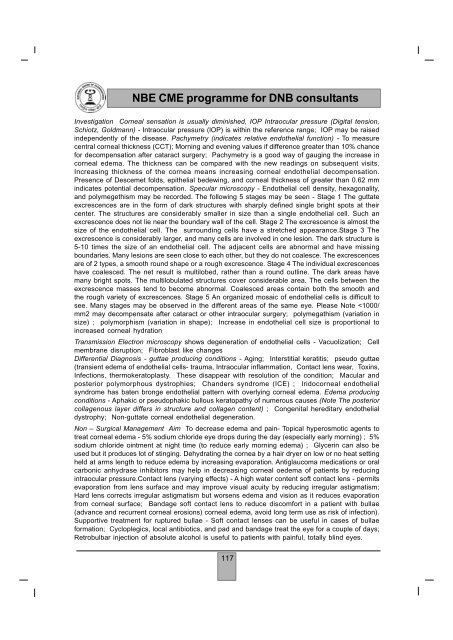<strong>NBE</strong> <strong>CME</strong> <strong>programme</strong> <strong>for</strong> <strong>DNB</strong> <strong>consultants</strong>Non-Surgical Management - Treat inflammation with topical and oral steroids; Treat infection ifany; Reduce Intraocular pressure, if raisedSurgical Managemet - Do a USG and if there is RD or element of traction on the surface of retinathen do an early vitrectomy and definitive RD surgery; Otherwise wait <strong>for</strong> at least 10-12 weeks <strong>for</strong>age. to resolve; Tie an encircling band if there is evidence of traction; Endolaser in Diabetics/Retinal Vasculitis/Vein OcclusionsFuch’s Endothelial Corneal Dystrophy (FECD)History- A patient may complain have less than satisfactory 6/6 vision-Early morning vision may bereported as misty. As the day progresses, the mist clears. An observant patient may make thiscomplaint, Mistiness may remain much longer than merely in the morning. It may persist the wholeday. In the early stages, it is improved by use of hypertonic drops and ointment; Patients may havedifficulty per<strong>for</strong>ming visual tasks, which require attention to fine letters or figures; Patients may seehalos around the sources of light; Patients may feel a gritty or <strong>for</strong>eign body sensation during partof or during the whole day; Progressive fall in the corrected visual acuity occurs over previousmonths or years; Attacks of redness, pain, and watering, lasting <strong>for</strong> hours or days occurs; Constantredness, pain, watering, and poor vision may be present; Rapid onset of symptoms of fadingvision and irritation after an intraocular operation, especially <strong>for</strong> cataract, may occur.Family History - Important as may be autosomal dominantPast history - <strong>Of</strong> medication used eg., topical sodium chloride 5%; antiglaucoma medication; Aslow and poor recovery of vision may occur after a cataract operation; Nd Y AG laser surgery <strong>for</strong>secondary cataract - increasing visual deterioration may develop, sometimes weeks or months.Demography - Elderly womenClinical Examination Bilateral ; Asymmetric disease of central cornea; Vision - Snellen’s chart;Retinoscopy - Red reflex reveals diffuse mottled appearance of descemets membraneLids - Lids are normal in early cases. -They may appear red and congested in advanced cases.Conjunctiva - Conjunctiva is normal in early cases; It may be highly congested, especially aroundthe limbus, when epithelial erosion, bullae <strong>for</strong>mation, or infected ulceration is present. Cornealepithelium - The corneal epithelium is normal and transparent in early cases; Bedewing of theepithelium occurs because of epithelial edema; Epithelial bullae may be present.; Pannus <strong>for</strong>mationoccurs; Ulceration with or without infection may be present; The corneal epithelium may be thickand opaque; Clouding of anterior cornea – technique-Indirect illumination, Sclerotic scatter ; LateSub epithelial scarring and end stage cicatrisation (diffuse sheet of scar) Bowmann’s scarring.Corneal stroma - The corneal stroma has a normal transparency in early cases; Appearance ofstriae in the deeper layers is observed due to folds in the Descemet membrane; Edema of thecorneal stroma occurs, first posteriorly and later anteriorly; Thickening of the corneal stromadevelops; Vascularization is present; Late A diffuse ground - glass like stromal haze of centralcornea. Descemet’s membrane – Thickened; Has a beaten-metal appearance. Cornealendothelaium - Corneal guttae multiple, central guttae associated with a fine stippling of pigmenton the posterior corneal surface.Method of examination - Direct illumination - Appearance of guttae Golden, refractile mounds onthe posterior corneal surface. Specular reflection - Black holes in the endothelial mosaic; Beatenmetal appearance may be seen in specular reflection. A similar appearance may be visible at theedge of the central corneal on retroillumination.(Please note Guttae are excrescences of Desceme’ts membrane produced by abnormal endothelialcells)Anterior chamber -is normal unless it is involved in some complication of the cornea. Pupillaryreaction - direct; consensual should be checked as associated glaucoma + optic atrophy (GOA)may go exist -Iris, lens, vitreous, and retina are not involved in the process; Lens changes shouldbe noted (cataract) (<strong>for</strong> surgical management).116
<strong>NBE</strong> <strong>CME</strong> <strong>programme</strong> <strong>for</strong> <strong>DNB</strong> <strong>consultants</strong>Investigation Corneal sensation is usually diminished, IOP Intraocular pressure (Digital tension,Schiotz, Goldmann) - Intraocular pressure (lOP) is within the reference range; IOP may be raisedindependently of the disease. Pachymetry (indicates relative endothelial function) - To measurecentral corneal thickness (CCT); Morning and evening values if difference greater than 10% chance<strong>for</strong> decompensation after cataract surgery; Pachymetry is a good way of gauging the increase incorneal edema. The thickness can be compared with the new readings on subsequent visits.Increasing thickness of the cornea means increasing corneal endothelial decompensation.Presence of Descemet folds, epithelial bedewing, and corneal thickness of greater than 0.62 mmindicates potential decompensation. Specular microscopy - Endothelial cell density, hexagonality,and polymegethism may be recorded. The following 5 stages may be seen - Stage 1 The guttateexcrescences are in the <strong>for</strong>m of dark structures with sharply defined single bright spots at theircenter. The structures are considerably smaller in size than a single endothelial cell. Such anexcrescence does not lie near the boundary wall of the cell. Stage 2 The excrescence is almost thesize of the endothelial cell. The surrounding cells have a stretched appearance.Stage 3 Theexcrescence is considerably larger, and many cells are involved in one lesion. The dark structure is5-10 times the size of an endothelial cell. The adjacent cells are abnormal and have missingboundaries. Many lesions are seen close to each other, but they do not coalesce. The excrescencesare of 2 types, a smooth round shape or a rough excrescence. Stage 4 The individual excrescenceshave coalesced. The net result is multilobed, rather than a round outline. The dark areas havemany bright spots. The multilobulated structures cover considerable area. The cells between theexcrescence masses tend to become abnormal. Coalesced areas contain both the smooth andthe rough variety of excrescences. Stage 5 An organized mosaic of endothelial cells is difficult tosee. Many stages may be observed in the different areas of the same eye. Please Note
















